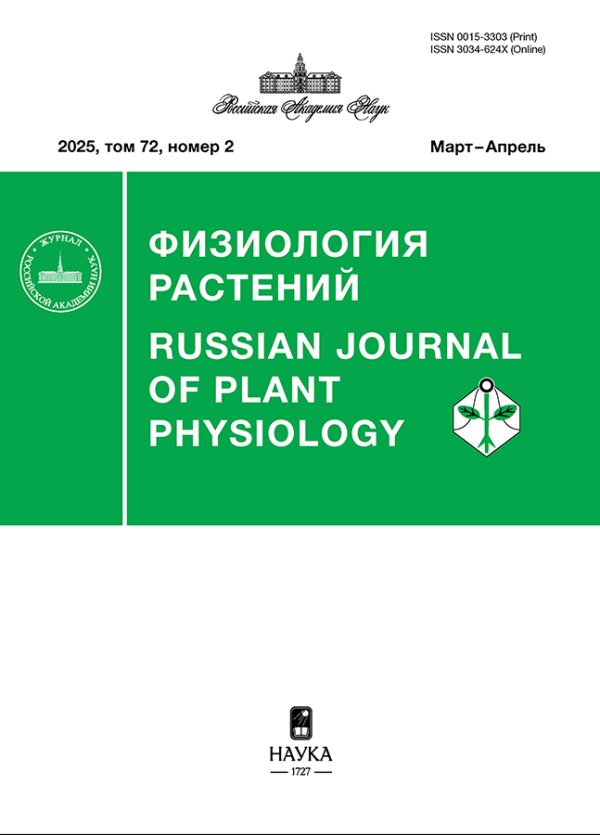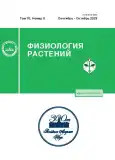Comparative Evaluation of the Effect of Copper Oxide and Copper Sulfate Nanoparticles on Structural and Functional Characteristics of Thalassiosira weissflogii under Conditions of Enrichment Cultivation // Russian Journal of Plant Physiology.
- Authors: Akimov A.I.1, Solomonova E.S.1, Shoman N.Y.1, Rylkova O.A.1
-
Affiliations:
- Kovalevsky Institute of Biology of the Southern Seas, Russian Academy of Sciences
- Issue: Vol 70, No 5 (2023)
- Pages: 494-505
- Section: ЭКСПЕРИМЕНТАЛЬНЫЕ СТАТЬИ
- URL: https://journals.rcsi.science/0015-3303/article/view/139782
- DOI: https://doi.org/10.31857/S0015330322600826
- EDN: https://elibrary.ru/PZQKPK
- ID: 139782
Cite item
Full Text
Abstract
The effect of copper oxide nanoparticles (500, 1000, 2000 μg/L) and copper ions (37.5, 75, 150 μg/L) on the morphological, structural-functional, and fluorescent parameters of diatom microalgae Thalassiosira weissflogii under conditions of long-term cultivation was studied. It was shown that copper in ionic form is more toxic for this microalgae species than in the form of a nanooxide. The nature of the effect of copper in ionic and nanoform on cells Thalassiosira weissflogii has both similarities and significant differences. The difference in the effect of the studied toxicants on the growth of algae and the performance of photosynthetic apparatus was revealed. The addition of copper ions into the cultivation medium led to long lag phase during the initial stage of the experiment, followed by the restoration of growth on days 3–6 of exposure. An increase in the concentration of copper oxide nanoparticles in the medium caused inhibition of algae growth without a pronounced lag phase. With an increase in the concentration of Cu2+ in the culture medium, a decrease in the quantum efficiency of light energy utilization by the PS II photosynthetic complex and the maximum relative electron transport rate were observed, while copper oxide nanoparticles had an insignificant effect on the efficiency of the photosynthetic apparatus ofThalassiosira weissflogii. With an increase in the concentration of copper, both in the ionic form and in the form of nanooxide, increase in cell volume, changes of cell shape and granularity, an increase in the production of reactive oxygen species, suppression of enzymatic activity and a decrease in autofluorescence values of individual cells in the red region of the spectrum were observed.
About the authors
A. I. Akimov
Kovalevsky Institute of Biology of the Southern Seas, Russian Academy of Sciences
Email: arkady.akimov@gmail.com
299011, Sevastopol, Russia
E. S. Solomonova
Kovalevsky Institute of Biology of the Southern Seas, Russian Academy of Sciences
Email: arkady.akimov@gmail.com
299011, Sevastopol, Russia
N. Yu. Shoman
Kovalevsky Institute of Biology of the Southern Seas, Russian Academy of Sciences
Email: arkady.akimov@gmail.com
299011, Sevastopol, Russia
O. A. Rylkova
Kovalevsky Institute of Biology of the Southern Seas, Russian Academy of Sciences
Author for correspondence.
Email: arkady.akimov@gmail.com
299011, Sevastopol, Russia
References
- Macfie S.M., Tarmohamed Y., Welbourn P.M. Effects of cadmium, cobalt, copper, and nickel on growth of the green alga Chlamydomonas reinhardtii: the influences of the cell wall and pH // Arch. Environ. Contam. Toxicol. 1994. V. 27. P. 454. https://doi.org/10.1007/BF00214835
- Echeveste P., Croot P., von Dassow P. Differences in the sensitivity to Cu and ligand production of coastal vs offshore strains of Emiliania huxleyi // Sci. Total Environ. 2018. V. 625. P. 1673. https://doi.org/10.1016/j.scitotenv.2017.10.050
- Nielsen E.S., Wium-Andersen S. Copper ions as poison in the sea and in freshwater // Mar. Biol. 1970. V 6. P. 93. https://doi.org/10.1007/BF00347237
- Pistocchi R., Guerrini F., Balboni V., Boni L. Copper toxicity and carbohydrate production in the microalgae Cylindrotheca fusiformis and Gymnodinium sp. // Eur. J. Psychol. 1997. V. 32. P. 125. https://doi.org/10.1080/09670269710001737049
- Cid A., Herrero C., Torres E., Abalde J. Copper toxicity on the marine microalga Phaeodactylum tricornutum: effects on photosynthesis and related parameters // Aquat. Toxicol. 1995. V. 31. P. 165. https://doi.org/10.1016/0166-445X(94)00071-W
- Perales-Vela H.V., González-Moreno S., Montes-Horcasitas C., Cañizares-Villanueva R.O. Growth, photosynthetic and respiratory responses to sub-lethal copper concentrations in Scenedesmus incrassatulus (Chlorophyceae) // Chemosphere. 2007. V. 67. P. 2274. https://doi.org/10.1016/j.chemosphere.2006.11.036
- Lage O.M., Parente A.M., Soares H.M.V.M., Vasconcelos M.T.S.D., Salema R. Some effects of copper on the dinoflagellates Amphidinium carterae and Prorocentrum micans in batch culture // Eur. J. Psychol. 1994. V. 29. P. 253. https://doi.org/10.1080/09670269400650711
- Miazek K., Iwanek W., Remacle C., Richel A., Goffin D. Effect of metals, metalloids and metallic nanoparticles on microalgae growth and industrial product biosynthesis: a review // Int. J. Mol. Sci. 2015. V. 16. P. 23929. https://doi.org/10.3390/ijms161023929
- Leal P.P., Hurd C.L., Sander S.G., Armstrong E., Roleda M. Copper ecotoxicology of marine algae: a methodological appraisal // Chem. Ecol. 2016. V. 32. P. 786. https://doi.org/10.1080/02757540.2016.1177520
- di Toppi L.S., Pawlik-Skowrońska B., Vurro E., Vattuone Z., Kalinowska R., Restivo F.M., Musetti R., Skowroński T. First and second line mechanisms of cadmium detoxification in the lichen photobiont Trebouxiaimpressa (Chlorophyta) // Environ. Pollut. 2008. V. 151. P. 280. https://doi.org/10.1016/j.envpol.2007.06.010
- Bundschuh M., Filser J., Lüderwald S., McKee M.S., Metreveli G., Schaumann G.E., Schulz R., Wagner S. Nanoparticles in the environment: where do we come from, where do we go to? // Environ. Sci. Eur. 2018. V. 30. P. 1. https://doi.org/10.1186/s12302-018-0132-6
- Dumont E.R., Elger A., Azéma C., Miche H.C., Surble S., Larue C. Cutting-edge spectroscopy techniques highlight toxicity mechanisms of copper oxide nanoparticles in the aquatic plant Myriophyllum spicatum // Sci. Total Environ. 2022. V. 803. P. 150001. https://doi.org/10.1016/j.scitotenv.2021.150001
- Keller A.A., McFerran S., Lazareva A., Suh S. Global life cycle releases of engineered nanomaterials // J. Nanopart. Res. 2013. V. 15. P. 1. https://doi.org/10.1007/s11051-013-1692-4
- Ivask A., Juganson K., Bondarenko O., Mortimer M., Aruoja V., Kasemets K., Blinova I., Heinlaan M., Slaveykova V., Kahru A. Mechanisms of toxic action of Ag, ZnO and CuO nanoparticles to selected ecotoxicological test organisms and mammalian cells in vitro: a comparative review // Nanotoxicology. 2014. V. 8. P. 57. https://doi.org/10.3109/17435390.2013.855831
- Xiong T.T., Dumat C., Dappe V., Vezin H., Schreck E., Shahid M., Pierart A., Sobanska S. Copper oxide nanoparticle foliar uptake, phytotoxicity, and consequences for sustainable urban agriculture // Environ. Sci. Technol. 2017. V. 51. P. 5242. https://doi.org/10.1021/acs.est.6b05546
- Adeleye A.S., Conway J.R., Garner K., Huang Y., Su Y., Keller A.A. Engineered nanomaterials for water treatment and remediation: costs, benefits, and applicability // Chem. Eng. J. 2016. V. 286. P. 640. https://doi.org/10.1016/j.cej.2015.10.105
- Lee W.M., An Y.J. Effects of zinc oxide and titanium dioxide nanoparticles on green algae under visible, UVA, and UVB irradiations: no evidence of enhanced algal toxicity under UV pre-irradiation // Chemosphere. 2013. V. 91. P. 536. https://doi.org/10.1016/j.chemosphere.2012.12.033
- Saison C., Perreault F., Daigle J.C., Fortin C., Claverie J., Morin M., Popovic R. Effect of core-shell copper oxide nanoparticles on cell culture morphology and photosynthesis (photosystem II energy distribution) in the green alga, Chlamydomonas reinhardtii // Aquat. Toxicol. 2010. V. 96. P. 109. https://doi.org/10.1016/j.aquatox.2009.10.002
- Wang Y., Zhu X., Lao Y., Lv X., Tao Y., Huang B., Wang J., Zhou J., Cai Z. TiO2 nanoparticles in the marine environment: physical effects responsible for the toxicity on algae Phaeodactylum tricornutum // Sci. Total. Environ. 2016. V. 565. P. 818. https://doi.org/10.1016/j.scitotenv.2016.03.164
- Oukarroum A., Halimi I., Siaj M. Cellular Responses of Chlorococcum sp. algae exposed to zinc oxide nanoparticles by using flow cytometry// Water Air Soil Pollut. 2019. V. 230. P. 1. https://doi.org/10.1007/s11270-018-4051-3
- Sendra M., Moreno-Garrido I., Blasco J., Araujo C.V. Effect of erythromycin and modulating effect of CeO2 NPs on the toxicity exerted by the antibiotic on the microalgae Chlamydomonas reinhardtii and Phaeodactylum tricornutum // Environ. Pollut. 2018. V. 242. P. 357. https://doi.org/10.1016/j.envpol.2018.07.009
- Wan J.K., Chu W.L., Kok Y.Y., Cheong K.W. Assessing the toxicity of copper oxide nanoparticles and copper sulfate in a tropical Chlorella // J. Appl. Phycol. 2018. V. 30. P. 3153. https://doi.org/10.1007/s10811-018-1408-3
- Huang W., Zhou Y., Zhao T., Tan L., Wang J. The effects of copper ions and copper nanomaterials on the output of amino acids from marine microalgae // Environ. Sci. Pollut. Res. 2022. V. 29. P. 9780. https://doi.org/10.1007/s11356-021-16347-3
- Соломонова Е., Муханов В. Оценка доли физиологически активных клеток в накопительных культурах Phaeodactylum tricornutum и Nitzschia sp. с помощью проточной цитометрии // Морской экологический журнал. 2011. Т. 10. С. 67.
- Wang H., Joseph J.A. Quantifying cellular oxidative stress by dichlorofluorescein assay using microplate reader // Free Radical Biol.Med. 1999. V. 27. P. 612. https://doi.org/10.1016/S0891-5849(99)00107-0
- Маторин Д.Н., Осипов В.А., Яковлева О.В., Погосян С.И. Определение состояния растений и водорослей по флуоресценции хлорофилла: учеб.-метод. пособие. М.: Макс Пресс, 2010. 116 с.
- Jeffrey R.F.C., Mantoura S.W. Phytoplankton Pigmentsin Oceanography: Guidelinesto Modern Methods // Monographson Oceanographic Methodology / Eds. S.W. Wright et al. Paris.UNESCO Publishing.1997. P.661.
- Брянцева Ю.В., Лях А.М., Сергеева А.В. Расчет объемов и площадей поверхности одноклеточных водорослей Черного моря. Севастополь: НАН Украины Институт биологии южных морей, 2005. 25 с.
- Galletti A., Seo S., Joo S.H., Su C., Blackwelder P. Effects of titanium dioxide nanoparticles derived from consumer products on the marine diatom Thalassiosira pseudonana // Environ. Sci. Pollut. Res. 2016. V. 23. P. 21113. https://doi.org/10.1007/s11356-016-7556-6
- Adeleye A.S., Keller A.A. Interactions between algal extracellular polymeric substances and commercial TiO2 nanoparticles in aqueous media // Environ. Sci. Technol. 2016. V. 50. P. 12258. https://doi.org/10.1021/acs.est.6b03684
- Flynn K.J. A mechanistic model for describing dynamic multi-nutrient, light, temperature interactions in phytoplankton // J. Plankton Res. 2001. V. 23. P. 977. https://doi.org/10.1093/plankt/23.9.977
- Gao G., Liu Y., Li X., Feng Z., Xu Z., Wu H., Xu J. Expected CO2-induced ocean acidification modulates copper toxicity in the green tide alga Ulva prolifera // Envir. Exper. Bot. 2017. V. 135. P. 63. https://doi.org/10.1016/j.envexpbot.2016.12.007
- Дмитриева А.Г., Даллакян Г.А., Лысенко Н.Л. Анализ функциональных показателей популяции водорослей в условиях накопления меди // Альгология. 1992. Т. 2. № 2. С. 30.
- Koppel D.J., Adams M.S., King C.K., Jolley D.F. Chronic toxicity of an environmentally relevant and equitoxic ratio of five metals to two Antarctic marine microalgae shows complex mixture interactivity // Environ. Pollut. 2018. V. 242. P. 1319. https://doi.org/10.1016/j.envpol.2018.07.110
- Xia B., Chen B., Sun X., Qu K., Ma F., Du M. Interaction of TiO2 nanoparticles with the marine microalga Nitzschia closterium: growth inhibition, oxidative stress and internalization // Sci. Total Environ. 2015. V. 508. P. 525. https://doi.org/10.1016/j.scitotenv.2014.11.066
- Franzitta M., Feijão E., Cabrita M.T., Gameiro C., Matos A.R., Marques J.C., Johannes W., Reis-Santos P., Fonseca V., Pretti C., Caçador I., Duarte B. Toxicity going nano: ionic versus engineered Cu nanoparticles impacts on the physiological fitness of the model diatom Phaeodactylum tricornutum // Front. Mar. Sci. 2020. V. 7. P. 1154. https://doi.org/10.3389/fmars.2020.539827
- Tang Y., Xin H., Yang F., Long X. A historical review and bibliometric analysis of nanoparticles toxicity on algae // J. Nanopart. Res.2018. V. 20. P. 1. doi.org/https://doi.org/10.1007/s11051-018-4196-4
- Pletikapić G., Žutić V., VinkovićVrček I., Svetličić V. Atomic force microscopy characterization of silver nanoparticles interactions with marine diatom cells and extracellular polymeric substance // J. Mol. Recognit. 2012. V. 2. P. 309. doi.org/https://doi.org/10.1002/jmr.2177
- Shaw A.K., Ghosh S., Kalaji H.M., Bosa K., Brestic M., Zivcak M., Hossain Z. Nano-CuO stress induced modulation of antioxidative defense and photosynthetic performance of Syrian barley (Hordeum vulgare L.) // Envir. Exper. Bot. 2014. V. 102. P. 37. https://doi.org/10.1016/j.envexpbot.2014.02.016
- Mahawar H., Prasanna R., Singh S.B., Nain L. Influence of silver, zinc oxide and copper oxide nanoparticles on the cyanobacterium Calothrix elenkinii // BioNanoScience. 2018. V. 8. P. 802. https://doi.org/10.1007/s12668-018-0543-2
- Marchello A.E., Barreto D.M., Lombardi A.T. Effects of titanium dioxide nanoparticles in different metabolic pathways in the freshwater microalga Chlorella sorokiniana (Trebouxiophyceae) // Water, Air, Soil Pollut. 2018. V. 229. P. 1. https://doi.org/10.1007/s11270-018-3705-5
- Wu D., Zhang J., Du W., Yin Y., Guo H. Toxicity mechanism of cerium oxide nanoparticles on cyanobacteria Microcystis aeruginosa and their ecological risks //Environ. Sci. Pollut. Res. 2022. V. 29. P. 34010. https://doi.org/10.1007/s11356-021-18090-1
- Fai P.B., Grant A., Reid B. Chlorophyll a fluorescence as a biomarker for rapid toxicity assessment // Environ. Toxicol. Chem. 2007. V. 26. P. 1520. https://doi.org/10.1897/06-394R1.1
Supplementary files















